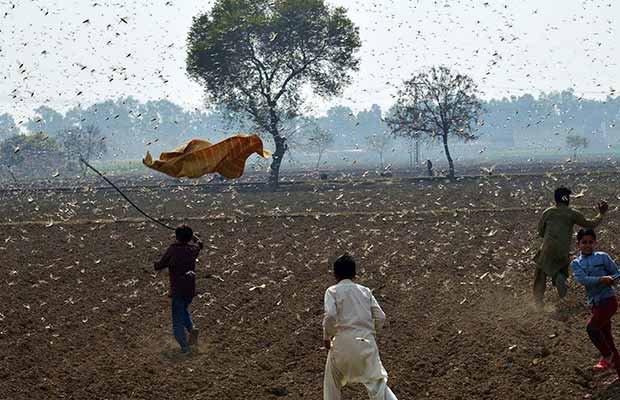Crops Damage under worst swarms of locusts attack in India

All worst situations has made clear that Bad luck of 2020 is not going to end in the first five months. After cyclone Amphan and pandemic corona virus, India is fighting with another battle against locust swarms. It seems like all scenes are playing like some Hollywood movie, with the kind of apocalyptic incidents taking place.
Swarms of locusts are troubling the farmers and people of Rajasthan, Uttar Pradesh, Madhya Pradesh, Punjab. Locusts have destroyed crops and trees while on the move. These swarms originated from and matured in, Iran and Pakistan’s Balochistan and passed through Jaisalmer and Barmer districts, arrived in Jaipur through Sikar and Nagaur, confounding the fears of residents.
#ALERT Swarms of locusts enter Jaipur, sharing frightening videos of attack#Swarms #LocustAttack #Locustsattack #Locusts #LocustAttackJaipur #farmersmarket #CropsDamage #tuesdayvibes #Rajasthan pic.twitter.com/EEC3nIUQGI
— Udti Khabar (@udtikhabarnews) May 26, 2020
Already India is fighting its battle against Covid-19 now we have another challenge the swarms of locusts attack. Challenge is that due to the insects ability to damage large portions of crops. This incident has left people worried, with many taking to social media to express their concern.
Plagued by Covid-19 lockdown and economic slowdown, the Indian economy is already on the edge. While experts are hoping that things will improve after a vaccine for the novel corona virus comes into the market, an agrarian crisis due to locust attack can postpone the plans of government off-balance.
#ALERT Swarm Of Locust (Desert Locust) Reached Panna Tiger Reserve,MP. From Twitter Feed of @ParveenKaswan #LocustAttack #locust https://t.co/vpNid2xUDV
— Rudro Singha Ray (@rudrosray) May 26, 2020
WHAT IS A LOCUSTS SWARM?
First, let’s understand what swarms of locust are and how they will damage farmers crops. Locusts is a type insect that travel in large swarms that can travel more than 150 kilometres in a day depending on the wind speed. Swarms of locusts devastate crops and cause damage of major agricultural, which can be reason of famine and starvation.
Locusts devour leaves, flowers, fruits, seeds, bark and growing points, and also destroy plants by their sheer weight as they descend on them in massive numbers.
A small swarm of the desert locust eats on an average as much food in one day as about 20 elephants, 30 camels, or 2,000 people.
But swarms are not always small. In 1875, the United State reported a swarm estimated to be 1,99,000 square miles or 5,12,818 square kilometres in size. Delhi-NCR is only 1,500 square kilometres, for comparison.



















